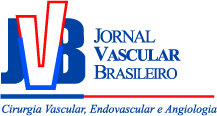Prevalência de resistência bacteriana nas infecções de ferida operatória em cirurgia arterial periférica
Prevalence of bacterial resistance in surgical wound infections in peripheral arterial surgery
Eduardo Lichtenfels; Airton D. Frankini; Jonas Paludo; Pedro A. d'Azevedo
Resumo
Palavras-chave
Abstract
Keywords
References
Frankini AD, Cardozo MA, Lichtenfels E. Infecção em prótese vascular. Cirurgia vascular. 2008:866-83.
Moreira RC. Infecção local pós-operatória em cirurgia arterial. Cir Vasc Angiol. 1995;11:46-54.
Bandyk DF. Infection in prosthetic vascular grafts. Vascular surgery. 2000:733-51.
França LH, Stahlke HJ, Garschagen MT, Parchen CF. Fatores de risco associados à infecção, amputação e mortalidade em pacientes submetidos a pontes arteriais infra-inguinais. J Vasc Bras. 2004;3:214-22.
Moreira RC. Infecção em Próteses Vasculares. Doenças Vasculares Periféricas. 2002:931-42.
Naylor AR, Hayes PD, Darke S. A Prospective Audit of Complex Wound and Graft Infection in Great Britain and Ireland: Emergence of MRSA. Eur J Vasc Endovasc Surg. 2001;21:289-94.
Terpstra S, Noordhoek GT, Voesten HG, Hendriks B, Degener JE. Rapid emergence of resistent coagulase-negative staphylococci on the skin after antobiotic prophylaxis. J Hosp Infect. 1999;49:195-202.
Cardozo MA, Frankini AD, Bonamigo TP. Use of superficial femoral vein in the treatment of infected aortoiliofemoral prothetic grafts. Cardivasc Surg. 2002;10:304-10.
Styers D, Sheehan DJ, Hogan P, Sahm DF. Laboratory-based survaillance of current antimicrobial resistance patterns and trends among Staphylococcus aureus: 2005 status in the United States. Ann Clin Microbiol Antimicrob. 2006;5:2-9.
Lichtenfels E, Lucas ML, Webster R, D`Azevedo PA. Profilaxia antimicrobiana em cirurgia vascular periférica: a cefazolina ainda é o padrão-ouro?. J Vasc Bras. 2008;6:378-87.
Cowie SE, Ma I, Lee SK, Smith RM, Hsiang YN, Abarca Aguilar F. Nosocomial MRSA Infection in Vascular Surgery Patients: Impact on Patient Outcome. Vasc Endovasc Surg. 2005;39:327-34.
Taylor MD, Napolitano LM. Methicillin-resistant Staphylococcus aureus infections in vascular surgery. Surg Infect (Larchmt). 2004;5:180-7.
Furuya EY, Lowy FD. Antimicrobial strategies for the prevention and treatment of cardiovascular infections. Curr Opin Pharmacol. 2003;3:464-9.
Antunes AL, Secchi C, Reiter KC, Perez LR, de Freitas AL, D'Azevedo PA. Feasible identification of Staphylococcus epidermidis using desferrioxamine and fosfomycin disks. APMIS. 2008;116:16-20.
Performance Standards for Antimicrobial Susceptibility Testing: CLSI International Informational Supplement. 2006.
Szylagyi DE, Smith RF, Elliot JP, Vrandecic MP. Infection in arterial reconstruction with synthetic grafts. Ann Surg. 1972;176:321-33.
Jones RN. Global aspects of antimicrobial resistance among key bacterial pathogensresults from the 1997-2001 Sentry Antimicrobial Program. Semin RespiClin Infect Dis. 2001;32:S81-S156.
System Report: Data summary from January 1992 through June 2004. Am J Infect Control. 2004;32:470-85.
Murray PR, Rosenthal KS, Pfaller MA. Microbiologia Médica. 2006.
Kang CI, Kim SH, Park WB. Bloodstream infections caused by antibiotic-resistant gram-negative bacilli: risk factors for mortality and impact of inappropriate initial antimicrobial therapy on outcome. Antimicrob Agents Chemother. 2005;49:760-6.
Chambers HF. The changing epidemiology of Staphylococcus aureus?. Emerg Infect Dis. 2001;7:178-82.
McGowan JE Jr. Economic impact of antimicrobial resistance. Emerg Infect Dis. 2001;7:286-92.
Cruse PJ, Foord R. The epidemiology of wound infection: A prospective study of 62, 939 wounds. Surg Clin North AM. 1980;60:27-40.
Dellinger EP. Infecções cirúrgicas e escolha dos antimicrobianos. Sabiston: Tratado de Cirurgia. 2003:182-200.
Fry DE. Surgical infections. 1995.
Howard RJ, Simmons RL. Surgical infectious disease. 2008.
Linton RR. The prophylactic use of the antibiotics in clean surgery. Surg Clin North AM. 1961;112:218-20.
Reifsnyder T, Bandik D, Seabrook G. Wound complications of in situ saphenous vein bypass technique. J Vasc Surg. 1992;15:843-8.
Rubin JR, Malone JM, Goldstone J. The role of the lynphatic system in acute arterial prostetic graft infections. J Vasc Surg. 1985;2:92-8.
Levy MF, Schmitt DD, Edmiston CE. Sequential analysis of staphylococcal colonization of body surfaces of patients undergoing vascular surgery. J Clin Microbiol. 1990;28:664-9.
Wengrovitz M, Atnip RG, Gifford RR. Wound complications of autogenous subcutaneous infrainguinal arterial bypass surgery: predisposing factors and management. J Vasc Surg. 1990;11:156-61.
Bandyk DF, Kinney EV, Reifsnyder T. Treatment of bacteria-biofilm graft infection by in situ replacement in normal and immune deficient states. J Vasc Surg. 1993;18:398-406.
Bergamini TM, Bandyk DF, Gorotstis D, Vetsch R, Towne JB. Identification of Staphylococcus epidermidis vascular graft infections: A comparison of culture techniques. J Vasc Surg. 1989;9:665-70.
Hicks RCJ, Greenhalgh RM. The pathogenesis of vascular graft infection. Eur J Vasc Endovasc Surg. 1997;14(^sA):5-9.
Moreira RCR. Estudo bacteriológico de linfonodos inguinais de pacientes submetidos à cirurgia arterial. 1991.
Timi JRR. Estudo bacteriológico da placa aterosclerótica da artéria femoral. 1992.
Robledo JA, Lopez J, Sierra P, Robledo C, Pfaller MA, Jones RN. El programa de vigilancia antimicrobiana Sentry em Colombia: hallazgos iniciales em tres hospitales de Medellin. Infectio. 1999;3:100-7.
Jones RN. Global epidemiology of antimicrobial resistance among community-acquired and nosocomial pathogens: A five-year summary from the Sentry Antimicrobial Surveillance Program (1997-2001). Semin Respir Crit Care Med. 2003;32:121-33.
Ferreira RBR. Simultaneous detection of the mecA and ileS-2 in coagulase-negative staphylococci isolated from Brazilian hospital by multiplex PCR. Diag Microbiol Infect Dis. 2002;42:205-12.
Sader HS. Pathogen frequency and resistance patterns in Brazilian hospitals: summary of results from three years of the Sentry Antimicrobial Surveillance Program. Braz J Infect Dis. 2001;5:200-14.

